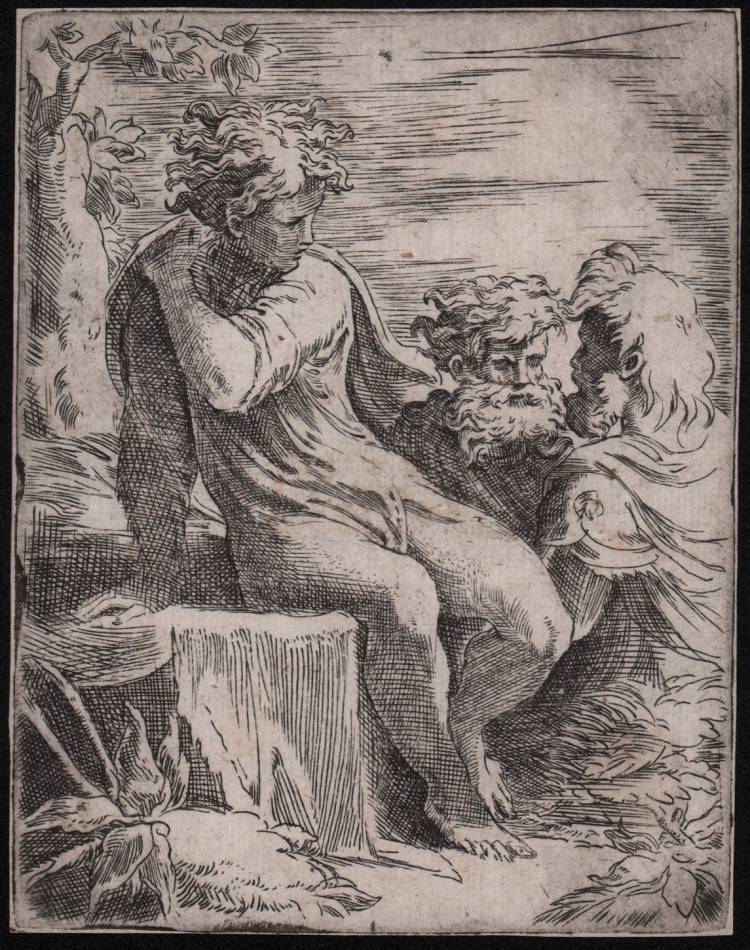



| Reference: | S42504 |
| Author | Francesco Maria Mazzola detto PARMIGIANINO |
| Year: | 1530 ca. |
| Measures: | 94 x 120 mm |


| Reference: | S42504 |
| Author | Francesco Maria Mazzola detto PARMIGIANINO |
| Year: | 1530 ca. |
| Measures: | 94 x 120 mm |
Etching and engraving, 1524-1530 circa.
A fine impression, printed on contemporary laid paper, itrimmed at the margins, very good condition.
The artist's interest in graphics began during his trip to Rome in 1524 where he frequented Marcantonio Raimondi and his workshop, learning the technique of the Bolognese master and the use of acid. In Rome he also met Ugo da Carpi from whom he learned the technique of chiaroscuro, ideal for the translation of the drawings into print. Here Parmigianino engraves St. Peter and St. John healing the sick (Bartsch 7), his famous first graphic work to 'etching derived from a drawing of Raphael.
The artist's choice to dedicate himself personally to a technique considered minor and marginal probably stems from the intuition of being able to reproduce in more than one copy his works which, through the use of etching, remained very close to the immediacy of the drawing, without showing the rigidity of translation typical of engraving with a burin. Mazzola dedicated himself to engraving in a sporadic way, due to the difficulties he encountered in using acid; for this reason, his works often present morsure defects, which distinguish most of the graphic work of this experimental master, often making the cataloguing of the states of the engravings controversial.
According to Mistrali's catalog there are three states of this etching; our exemplar presents characteristics common to the second and third state, confirming the usual difference of impressions typical of Parmigianino's works, which are very difficult to catalogue.
Mistrali describes this third state: “The plate has been reworked a e burin, and now patches of clear sky may be distinguished. In some cases, the first state and the third were considered to be one a copy of the other. In fact, it is always the same plate that is modified. This is borne out by the numerous prints consulted, in fact, some small defects appear, such as the hole in the metal that can be seen in the upper center, in the patch of sky above the head of the youth, or the slight scratch between the youth’s right foot of the and the tuft of grass in the lower right corner".
Bibliografia
Bartsch XVI.13.13; Mistrali, p. 96 n. 11, III/III; Le Blanc vol. 2, p. 630, no. 14; Gnann 2007a, no. 20.
Francesco Maria Mazzola detto PARMIGIANINO (Parma 1503 – Casal Maggiore 1540)
|
Italian painter, draughtsman and printmaker. Beginning a career that was to last only two decades, he moved from precocious success in the shadow of Correggio in Parma to be hailed in the Rome of Clement VII as Raphael reborn. There he executed few large-scale works but was introduced to printmaking. After the Sack of Rome in 1527, he returned to northern Italy, where in his final decade he created some of his most markedly Mannerist works. Equally gifted as a painter of small panels and large-scale frescoes both sacred and profane, he was also one of the most penetrating portrait painters of his age. Throughout his career he was a compulsive draughtsman, not only of preparatory studies for paintings and prints, but also of scenes from everyday life and of erotica.
|
Francesco Maria Mazzola detto PARMIGIANINO (Parma 1503 – Casal Maggiore 1540)
|
Italian painter, draughtsman and printmaker. Beginning a career that was to last only two decades, he moved from precocious success in the shadow of Correggio in Parma to be hailed in the Rome of Clement VII as Raphael reborn. There he executed few large-scale works but was introduced to printmaking. After the Sack of Rome in 1527, he returned to northern Italy, where in his final decade he created some of his most markedly Mannerist works. Equally gifted as a painter of small panels and large-scale frescoes both sacred and profane, he was also one of the most penetrating portrait painters of his age. Throughout his career he was a compulsive draughtsman, not only of preparatory studies for paintings and prints, but also of scenes from everyday life and of erotica.
|